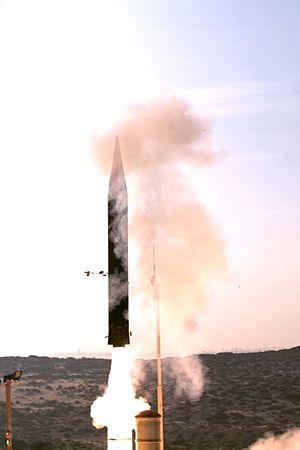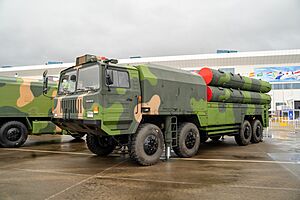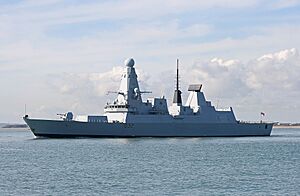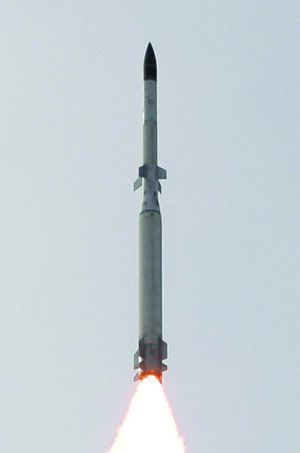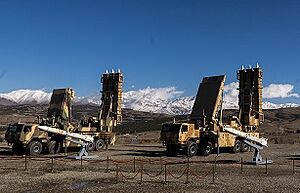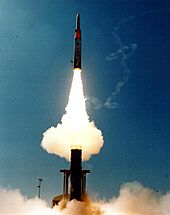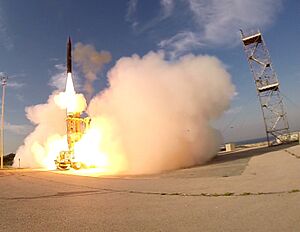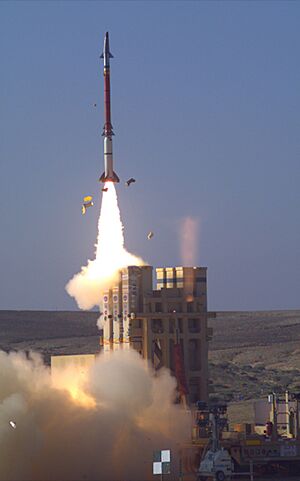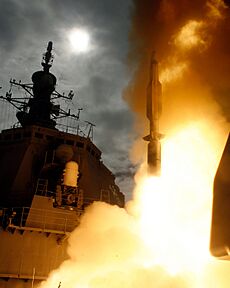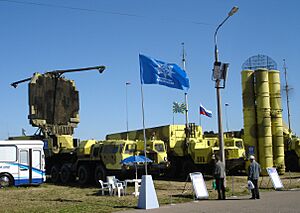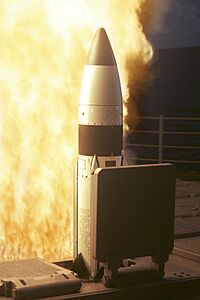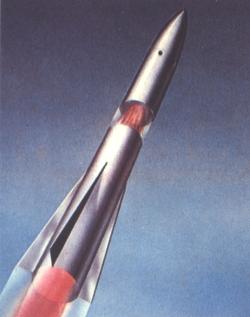Anti-ballistic missile facts for kids
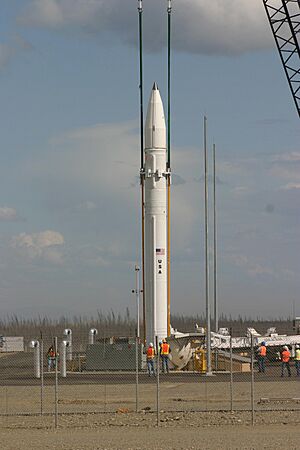
An anti-ballistic missile (ABM) is a special type of surface-to-air missile. Its job is to stop and destroy ballistic missiles while they are flying. These missiles can be destroyed by exploding near them or by hitting them directly with a special vehicle called a kinetic vehicle. These kinetic vehicles can also steer themselves.
Some ABM systems are used to protect against shorter-range ballistic missiles. These missiles usually carry regular, non-nuclear warheads. Many countries use these systems.
Other, more advanced ABM systems are used by countries like the United States, Russia, and Israel. These systems can intercept very long-range missiles, called intercontinental ballistic missiles (ICBMs). ICBMs are often designed to carry very powerful warheads. During a time of tension known as the Cold War, a treaty in 1972, called the ABM Treaty, helped limit the number of these powerful missiles. This was to prevent a race where countries would build too many ICBMs to try and overwhelm missile defense systems. Today, most modern ABM systems use non-explosive ways to stop missiles. Only Russia's strategic ABM systems still use special warheads for interception.
Contents
- Stopping Long-Range Missiles
- Shorter-Range Missile Defense Systems
- History of Anti-Ballistic Missiles
- Early Ideas (1940s and 1950s)
- Soviet Union's Early Efforts
- American Nike-X and Sentinel
- Defense Against Multiple Warheads
- The ABM Treaty of 1972
- Safeguard System (1975-1976)
- SDI Experiments (1980s)
- Tactical ABMs in the 1990s
- Brilliant Pebbles Idea
- SDI to MDA, NMD/GMD Development
- 21st Century Developments
- See also
Stopping Long-Range Missiles
Only a few systems around the world can stop intercontinental ballistic missiles (ICBMs). These are very long-range missiles.
- The Russian A-135 anti-ballistic missile system protects Moscow. It started working in 1995. Its missiles, called Gorgon and Gazelle, were updated in 2017. They now use non-explosive interceptors to hit incoming ICBMs.
- The Israeli Arrow 3 system began operating in 2017. It is designed to intercept ballistic missiles high above Earth, in space. This includes ICBMs. It can also be used to stop satellites.
- The American Ground-Based Midcourse Defense (GMD) system was first tested in 1997. It had its first successful test in 1999. Instead of exploding, it launches a special projectile that hits the ICBM directly. The GMD system aims to protect the United States from a limited attack by certain countries. It has about 44 interceptors. This system is not designed to protect against a very large attack from a major power.
- The Aegis ballistic missile defense system uses the SM-3 Block II-A missile. In November 2020, this missile showed it could shoot down an ICBM target.
- In that test, the US launched a practice ICBM from Kwajalein Atoll. It flew towards Hawaii. A satellite detected it and sent a warning. A ship, the USS John Finn, then launched a missile. This missile destroyed the practice ICBM high above the atmosphere.
Missile Defense in Europe
For many years, countries have discussed how to protect Europe from ballistic missiles. In the early 2000s, the United States planned to set up an advanced ABM system in Central Europe. This system would have a radar in the Czech Republic and missile launchers in Poland. The goal was to defend against long-range missiles from countries like Iran and North Korea. These plans led to discussions among different countries, including Russia. Later, more details emerged about Aegis Ashore sites being built in Romania (2014) and Poland (2018). These sites are part of a broader missile defense effort.
Shorter-Range Missile Defense Systems
China's Missile Defense
Past Efforts in China
China started its own project, called Project 640, in 1969 to develop ABM technology. This project included sensors, guidance systems, and different types of interceptor missiles. Some of these missiles had successful test flights. However, the project slowed down due to money and political reasons. It was eventually stopped in 1980.
China's Current Systems
China has tested interceptor systems similar to the US Patriot missiles. China also uses and builds the S-300PMU-2/S-300PMU-1 series of missiles, which can stop missiles at the end of their flight. The HQ-9 and HQ-15 missile systems may also have this ability. China's modern navy destroyers, like the Type 052C and Type 051C, carry naval HQ-9 missiles.
The HQ-19 missile, similar to the THAAD system, was first tested in 2003. The HQ-29, which is like the MIM-104F PAC-3, was first tested in 2011.
China conducted a land-based anti-ballistic missile test on January 11, 2010. The intercept happened in space, in the middle part of the target missile's flight. The interceptor missile was an SC-19. China conducted another anti-ballistic missile test on January 27, 2013. The Chinese Defense Ministry stated it was for defense and not aimed at any country. On February 4, 2021, China reportedly did another mid-course intercept test.
European Missile Defense
Aster Missiles
The Aster is a group of missiles made by France and Italy. The Aster 30 versions can defend against ballistic missiles. The United Kingdom also uses the Aster 30 Block 0.
In 2010, France announced a successful test of the Aster 30 missile against a ballistic target. In 2011, it successfully intercepted a Black Sparrow target missile. Ships from the French, Italian, and Royal Navy use Aster 15 and Aster 30 missiles. France and Italy are developing a new Aster 30 Block II. This version will be able to destroy ballistic missiles flying up to 3,000 km (1,900 mi) away. It will use a special kill vehicle to hit targets.
HYDIS² Project
The HYDIS² project, involving France, Italy, Germany, and the Netherlands, was announced in June 2023. It is led by MBDA and partly funded by the European Defense Fund. Its goal is to study how to develop an interceptor missile to counter new, very fast threats. HYDIS² focuses on MBDA's Aquila hypersonic missile interceptor idea. It involves many partners from 14 European countries. This project aims to create a defense that could be part of the EU TWISTER program. TWISTER, started in 2019, is an air defense system for early warning, tracking, and stopping advanced air threats, including ballistic missiles.
EU HYDEF Project
The EU HYDEF project is another effort to develop an interceptor missile. It is also related to the TWISTER program and is partly funded by the European Defense Fund. This project is coordinated by Spain's SENER Aeroespacial Sociedad Anonima. Germany's Diehl Defence leads the technical side.
India's Missile Defense
In November 2006, India successfully tested its Prithvi Air Defence (PAD) system. This system intercepts missiles outside the atmosphere. During the test, the PAD missile intercepted a target missile at an altitude of 50 km (31 mi). On December 6, 2007, the Advanced Air Defence (AAD) missile system was successfully tested. This missile intercepts targets inside the atmosphere at an altitude of 30 km (19 mi).
The DRDO is also developing a new interceptor missile called PDV. This missile is designed to hit targets at altitudes above 150 km (93 mi). The first PDV was successfully tested on April 27, 2014. On May 15, 2016, India successfully launched the AAD, now called Ashwin.
As of January 8, 2020, India's BMD program is complete. The Indian Air Force and DRDO are waiting for government approval to deploy the system. It will first protect New Delhi and Mumbai, then other major cities. PAD and PDV are for mid-flight interception, while AAD is for interception at the end of the flight.
Iran's Missile Defense
Iran uses the Arman and S-300 missile systems for ballistic missile defense.
Israel's Missile Defense
Arrow 2 System
The Arrow project began in 1986 with funding from the U.S. and Israel. It was designed and built in Israel. In 1998, the Israeli military successfully tested their Arrow missile. It is designed to intercept incoming missiles. In 2004, Israel and the United States conducted a joint test where the Arrow successfully destroyed a real Scud missile with a direct hit. This success was repeated in tests in 2005 and 2007 against a replicated Shahab-3 missile.
Arrow 3 System
The Arrow 3 system can intercept ballistic missiles high above Earth, including ICBMs. It can also act as an anti-satellite weapon. Lieutenant General Patrick J. O'Reilly, a director from the US Missile Defense Agency, said that the Arrow 3 design promises to be a very capable system, more advanced than what the U.S. has attempted. In December 2015, Arrow 3 successfully intercepted a target in a complex test. This test helped confirm how the system can find, identify, track, and then tell the difference between real and fake targets in space. This success helps move the Arrow 3 towards production.
David's Sling System
David's Sling is a military system developed by Israeli and American companies. It is designed to intercept tactical ballistic missiles, as well as medium- to long-range rockets and slower-flying cruise missiles. It can stop threats fired from 40 km to 300 km away. It is designed to intercept newer types of tactical ballistic missiles, like the Iskander.
Japan's Missile Defense
Since 1998, Japan has been working with the US to develop a new surface-to-air interceptor called the Patriot Advanced Capability 3 (PAC-3). Tests have been successful. Japan plans to install PAC-3 systems in 11 locations, usually near major air bases or military storage centers. Japan has also installed a US-developed ship-based anti-ballistic missile system. This system was successfully tested in 2007. Japan has four destroyers that can carry the RIM-161 Standard Missile 3 and are equipped with the Aegis Ballistic Missile Defense System. Japan is modifying four more destroyers to join its ballistic missile defense force, bringing the total to eight ships.
Russia's Missile Defense
Russia's Moscow ABM defense system is designed to intercept ICBM warheads aimed at Moscow and other important areas. It uses several missile systems:
- A-35 Aldan
- ABM-1 Galosh / 5V61 (no longer used)
- A-35M
- ABM-1B (no longer used)
- A-135 Amur
- ABM-3 Gazelle / 53T6
- ABM-4 Gorgon / 51T6 (no longer used)
- A–235 Nudol (still being developed)
- S-300P (SA-10)
- S-300V/V4 (SA-12)
- S-300PMU-1/2 (SA-20)
- S-400 (SA-21)
- S-300VM (SA-23)
- S-500 Prometey (production started in 2021)
United States Missile Defense
The U.S. military has shown it can destroy both long and short-range ballistic missiles. Newer systems are very effective against older tactical ballistic missiles. For example, the MIM-104 Patriot (PAC-1 and PAC-2) had a high success rate in Operation Iraqi Freedom.
The U.S. Navy's Aegis Ballistic Missile Defense System (Aegis BMD) uses the RIM-161 Standard Missile 3. This missile can hit targets moving very fast. In November 2020, an SM-3 Block IIA successfully destroyed an ICBM in mid-flight.
The U.S. Army's Terminal High Altitude Area Defense (THAAD) system began production in 2008. It is designed to intercept short to intermediate ballistic missiles. It can hit missiles that are coming down from space. THAAD has repeatedly shown it can intercept missiles in their flight path.
The U.S. Army's Ground-Based Midcourse Defense (GMD) system was developed by the Missile Defense Agency. It uses ground-based radars and mobile X-band radars. It has 44 interceptors in underground silos in California and Alaska. These protect against limited ICBM attacks from certain countries. Each Ground-Based Interceptor (GBI) rocket carries a special kill vehicle that hits the target directly.
Since 2004, the United States Army plans to replace older control systems with the Integrated Air and Missile Defense Battle Command System (IBCS). This system is designed to shoot down short, medium, and intermediate range ballistic missiles by hitting them directly. IBCS will help identify and track targets using information from different sensors. It will also choose the best interceptor missiles from available launchers. In February 2022, THAAD radar and its control system showed they could work with Patriot PAC-3 MSE missile launchers. They engaged targets using both THAAD and Patriot interceptors.
Taiwan's Missile Defense
Taiwan uses MIM-104 Patriot missiles and its own Tien-Kung anti-ballistic missile systems. Because of tensions with China, Taiwan developed the Sky Bow (or Tien-Kung). This surface-to-air missile can intercept and destroy enemy aircraft and ballistic missiles. This system was created with help from Raytheon Technologies. It uses the Chang Bai S-band radar system. The missiles have a range of 200 km and are designed to take on fast-moving targets that are hard to detect. The newest version is the Sky Bow III (TK-3).
South Korea's Missile Defense
South Korea has been developing its missile defense program due to North Korea's missile activities. South Korea started by getting 8 batteries of MIM-104 Patriot (PAC-2) missiles from the United States. The PAC-2 was originally for aircraft, but South Korea is upgrading to the PAC-3. The PAC-3 can hit incoming missiles directly.
South Korea has been trying to develop its own defense system since the 1990s. The South Korean Defense Acquisition Program Administration (DAPA) confirmed a test launch of the L-SAM system in February 2022. This missile has been in development since 2019. It is South Korea's next generation anti-ballistic missile. It is expected to have a range of 150 km and intercept targets between 40 km and 100 km high. It can also intercept aircraft. The L-SAM system is expected to be ready by 2024.
History of Anti-Ballistic Missiles
Early Ideas (1940s and 1950s)
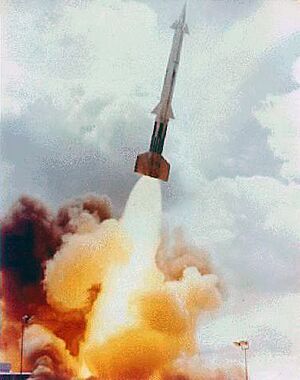
The idea of stopping rockets before they hit their target began during World War II. This was when Germany used its V-1 and V-2 rockets. British fighter planes destroyed some V-1 "buzz bombs." However, anti-aircraft guns with radar had more success, stopping about 95% of V-1s that entered their range. The V-2 was the first true ballistic missile. There are no known cases of it being destroyed in the air. Radars could track V-2s to give warnings, but they couldn't stop them.
After World War II, the American armed forces started experimenting with anti-missile missiles. Project Wizard began in 1946 to create a missile that could intercept the V-2. Defenses against long-range bombers were a higher priority until 1957. That year, the Soviet Union launched Sputnik, the first artificial satellite. This showed their progress in ICBM technology. The US Army then sped up the development of their LIM-49 Nike Zeus system. The Zeus project was eventually stopped in 1963.
In 1958, the U.S. explored if exploding special warheads high in the air could stop ICBMs. This was found not to be effective for stopping warheads.
Soviet Union's Early Efforts
The Soviet military began ABM research in 1953. Their test system, called System A, used the V-1000 missile. The first successful test interception happened on November 24, 1960. The first test with a live warhead was on March 4, 1961. In this test, a practice warhead was launched and destroyed by a V-1000 missile high in the air.
The V-1000 system was not considered reliable enough. So, the Soviets developed larger missiles like the Fakel 5V61 (known as Galosh in the west). This missile carried a larger warhead and could fly much further. Further development led to the A-35 anti-ballistic missile system, which became operational in 1971 to protect Moscow.
The A-35 was upgraded in the 1980s to a two-layer system, the A-135. The Gorgon long-range missile was for intercepts outside the atmosphere. The Gazelle short-range missile handled intercepts inside the atmosphere that the Gorgon missed.
American Nike-X and Sentinel
The Nike Zeus system could only attack one target at a time. This made it less useful as more ICBMs were being built. Also, there were concerns about its ability to work if other explosions happened high in the atmosphere. By 1963, when Nike Zeus was canceled, new upgrades were being explored. These included radars that could scan larger areas and track many warheads at once. A new missile, the Nike-X, was designed to attack incoming warheads at lower altitudes.
The main missile for Nike-X was the LIM-49 Spartan. It was an upgraded Nike Zeus with a larger warhead to destroy enemy warheads in space. A second, shorter-range missile called Sprint was added. Sprint was very fast and had a smaller warhead for interceptions inside the atmosphere.
The success of Nike X tests led the US government to propose a smaller ABM defense system. In 1967, Defense Secretary Robert McNamara called it "Sentinel". He said it would defend against potential threats from countries like China.
Defense Against Multiple Warheads
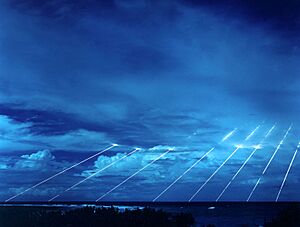
ABM systems were first developed to stop single warheads from large ICBMs. It seemed simple: the cost of a large ICBM should be more than the smaller interceptor missile. So, the defense would always win in terms of cost. However, interceptor missiles were very complex and expensive. They needed advanced guidance systems. Also, many interceptors were needed for every ICBM, because the target of the warhead wouldn't be known in advance.
Things changed in 1970 with the introduction of multiple independently targetable reentry vehicle (MIRV) warheads. Suddenly, one missile could launch not one, but several warheads. These warheads would spread out, meaning each one would need its own interceptor. This made ABM systems much more expensive than the ICBMs they were trying to defend against.
The ABM Treaty of 1972
Because of these technical, economic, and political challenges, the ABM Treaty was signed in 1972. This treaty limited the number of strategic anti-ballistic missiles countries could deploy. Under the treaty, each country could only have 100 ABMs to protect one small area. The Soviets kept their Moscow defenses. The U.S. chose to protect its ICBM sites in North Dakota, where the Safeguard system was already being built. The missiles there were deactivated in 1975.
Safeguard System (1975-1976)
The U.S. Safeguard system used the LIM-49A Spartan and Sprint missiles. It was operational for a short time in 1975-1976. This was the second system in the world designed to counter ICBMs. Safeguard protected only the main fields of US ICBMs. The idea was to ensure that if an attack happened, the US could still launch its own missiles in response.
SDI Experiments (1980s)
The Reagan-era Strategic Defense Initiative (often called "Star Wars") brought new interest in ABM technologies. SDI was a very ambitious program to create a complete shield against a massive ICBM attack. It imagined large laser stations in space and other advanced technologies. SDI remained a research program and was never fully deployed. However, some technologies developed from SDI are used by today's Missile Defense Agency (MDA).
Tactical ABMs in the 1990s
The Israeli Arrow missile system was first tested in 1990. The United States supported the Arrow project throughout the 1990s.
The Patriot was the first tactical ABM system to be used in combat. It was used during the 1991 Gulf War to try and intercept Iraqi Scud missiles. Later analysis showed it was less effective than first thought. This was because its radar had trouble telling the difference between warheads and other parts when the Scud missiles broke apart.
After the Gulf War, improvements were made to several U.S. air defense systems. A new Patriot, PAC-3, was developed and tested. This was a complete redesign of the earlier PAC-2. It had improved guidance, radar, and missile performance. During Operation Iraqi Freedom, Patriot batteries engaged all enemy missiles in their area. Most of these were successfully destroyed.
A new version of the Hawk missile was tested in the 1990s. By 1998, most US Marine Corps Hawk systems were updated to have basic anti-ballistic missile abilities. The MIM-23 Hawk missile is no longer used by the U.S., but many other countries still use it.
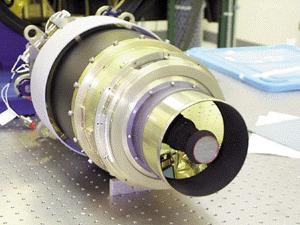
Soon after the Gulf War, the Aegis Combat System was updated to include ABM capabilities. The Standard missile system was also improved and tested for intercepting ballistic missiles. In the late 1990s, SM-2 block IVA missiles were tested for theater ballistic missile defense. Standard Missile 3 (SM-3) systems have also been tested for an ABM role. In 2008, an SM-3 missile launched from the Ticonderoga-class cruiser USS Lake Erie successfully intercepted a non-working satellite.
Brilliant Pebbles Idea
The "Brilliant Pebbles" idea was proposed in 1991 but never built. It was a plan for a space-based anti-ballistic system. Instead of large laser stations, it would use thousands of very small, smart satellites with kinetic warheads. These small interceptors would work together to target many ICBM warheads in space. This idea was meant to be less expensive and less risky to develop. Development was stopped later in favor of ground-based defense.
SDI to MDA, NMD/GMD Development
The Reagan-era Strategic Defense Initiative aimed to protect against a massive attack. In the early 1990s, President George H. W. Bush called for a more limited version. This version would use rocket-launched interceptors based on the ground at one site. This system was developed starting in 1992. It was expected to be ready by 2010 and could intercept a small number of incoming ICBMs. First called the National Missile Defense (NMD), it was renamed Ground-Based Midcourse Defense (GMD) in 2002. It was planned to protect all 50 states from a missile attack by certain countries.
In 1998, Defense Secretary William Cohen proposed spending more money on ICBM defense programs. This was to build a system to protect against attacks from North Korea or accidental launches from Russia or China. In terms of organization, SDI was reorganized as the Ballistic Missile Defense Organization in 1993. In 2002, it was renamed the Missile Defense Agency (MDA).
21st Century Developments
On June 13, 2002, the United States left the Anti-Ballistic Missile Treaty. It then restarted developing missile defense systems that the treaty had previously forbidden. The US stated this was needed to defend against possible missile attacks from certain countries. The next day, Russia dropped the START II agreement, which aimed to ban MIRVs.
At the 2010 Lisbon summit, NATO adopted a program to respond to the growing threat of ballistic missiles. This was because of a rapid increase in ballistic missiles from potentially unfriendly countries. At this time, Iran was seen as a likely threat, as it has the largest missile collection in the Middle East. Russia saw NATO's ABM system as a threat to its ability to respond to nuclear threats. Russia suggested that any ABM system by NATO should be universal and cover all of Europe.
On December 15, 2016, the US Army SMDC successfully tested a Zombie Pathfinder rocket. This rocket is used as a target for practicing different anti-ballistic missile situations. The rocket was launched as part of NASA's sounding rocket program.
In November 2020, the US successfully destroyed a practice ICBM. The ICBM was launched from Kwajalein Atoll towards Hawaii. A satellite detected it and warned a US Air Force base. The USS John Finn then launched an SM-3 Block IIA missile. This missile destroyed the practice ICBM while it was still outside the atmosphere.
See also
- 2010 Chinese anti-ballistic missile test
- Aegis Ballistic Missile Defense System
- Atmospheric entry
- Command systems in the United States Army
- Comparison of anti-ballistic missile systems
- Indian Ballistic Missile Defence Programme
- Kinetic kill vehicle
- Missile defense
- Anti-torpedo torpedoes
- Multiple Kill Vehicle
- National Missile Defense
- Nuclear disarmament
- Nuclear proliferation
- Nuclear warfare
- Safeguard/Sentinel ABM system
- Spartan (missile)
- Sprint (missile)
- Terminal High Altitude Area Defense
- Intercontinental ballistic missile


